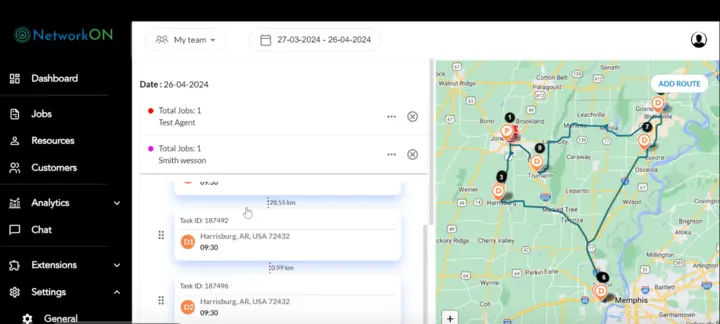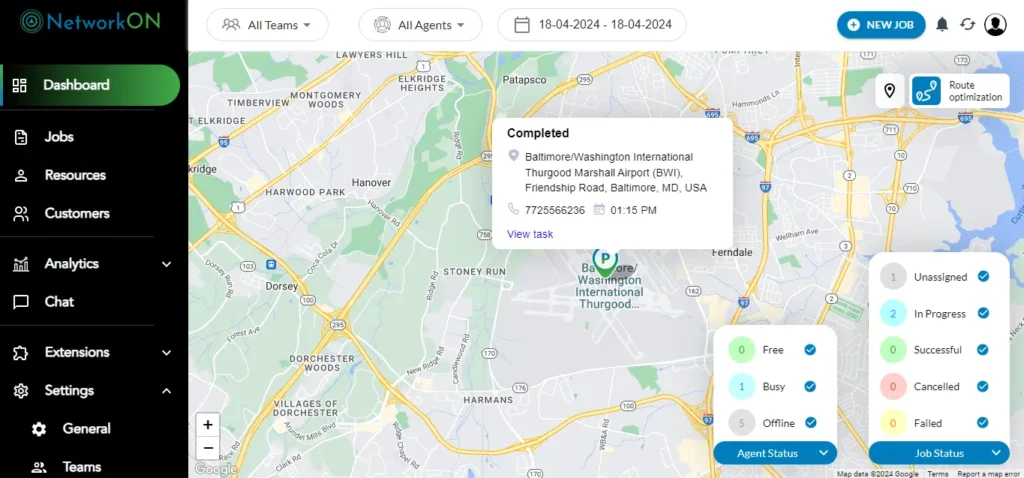Table of Contents
Enter the realm of logistics software solutions, where streamlined operations are not a distant dream but a tangible reality. These tools are the lynchpins in enhancing operational efficiency and elevating service quality, granting businesses a competitive edge. Through minimizing errors and sharpening delivery times, logistics software solutions provide a launchpad for excellence in supply chain management.

Transport, warehousing, and order management complexities often present significant business challenges. Advanced logistics software integration capabilities address these challenges by harmonizing disparate processes into a cohesive and efficient workflow. This technology empowers businesses to master the intricacies of their supply chains and confidently drive their growth trajectory upward.
Staying Ahead with Supply Chain Management Software
Logistics professionals face complex challenges in today’s fast-paced market. Supply chain management software provides centralized control, transforming intricate logistics processes into streamlined operations. Managers harness this technology to efficiently orchestrate the tasks required to move products from origin to destination.
Centralized Control Over Multi-Faceted Logistics Processes
Supply chains comprise various stages, each with its unique demands. Centralized control is not simply a feature but a command center for coordinating transportation, warehousing, inventory management, and order fulfillment. This consolidation eliminates silos, fostering transparent workflows and synergy across all logistical functions.
Real-Time Data for Better Decision-Making and Shipments Management
Dynamic environments require adaptive strategies. Real-time data keeps teams informed, allowing them to react promptly to the unpredictable. Managers monitoring shipments gain insights into status updates, delivery ETAs, and potential disruptions, enabling proactive measures to mitigate risks and keep the supply chain moving without interruption.
Collaboration Benefits Between Different Stakeholders
The interconnectivity between suppliers, carriers, and customers lies at the heart of smooth operations. Collaboration is facilitated through a platform integrating stakeholders, where each can access necessary information and communicate effortlessly. This results in a unified network that is resilient and responsive to changes, fostering lasting partnerships.
Efficiency: Unified logistics software solutions eliminate redundancy, reduce errors, and save time.
Visibility: Stakeholders obtain a panoramic view of the supply chain, ensuring transparency.
Adaptability: Businesses can pivot with agility, aligning with market demands and adjusting strategies spontaneously.
Adopting supply chain management software is about keeping pace and setting the bar in logistics execution. This adoption results in a measurable competitive advantage, marked by optimized processes and enhanced satisfaction for all parties involved.
Warehouse Management Systems (WMS) Unpacked
Warehouse Management Systems (WMS) are the technological backbone of modern warehouse operations. These systems are at the forefront of operational efficiency, streamlining daily tasks through sophisticated software.
Features of WMS that optimize storage and movements within a warehouse
- Automated data collection ensures real-time tracking of products and materials.
- Advanced picking algorithms reduce retrieval time. Zone-picking strategies are achieved through systematic storage optimization.
- RFID and barcode integrate and accelerate inventory movements with precision.
By leveraging these features, companies enhance the speed and accuracy of warehouse operations, directly influencing overall productivity.
How WMS contributes to effective inventory management
Central to the efficacy of WMS is its robust inventory management capabilities. Real-time inventory visibility prevents stockouts and overstock situations. Sophisticated WMS platforms enable companies to execute just-in-time inventory practices, reducing holding costs and improving cash flow. Seamless tracking across the entire inventory lifecycle from receipt to shipment is assured, mitigating risks associated with inventory obsolescence and shrinkage.
Integration with other logistics software for seamless operations
WMS is not an island but an integral part of a larger ecosystem of logistics software solutions. Integration with procurement systems allows for streamlined restocking processes. Harmony with Transportation Management Systems (TMS) ensures coordinated efforts in outbound logistics. Robust Application Programming Interfaces (APIs) foster communication between WMS and Enterprise Resource Planning (ERP) systems, ensuring consistent and reliable data throughout the supply chain.
Through the implementation of WMS, enterprises experience heightened control and a granular management level over warehousing operations. This digital transformation supports their ability to meet customer demands with agility and resilience.
Streamlining Transportation with Transportation Management Systems (TMS)
Transportation Management Systems (TMS) present a fusion of technology and innovation, reshaping the transportation framework within the logistics sphere. By incorporating TMS, businesses obtain multifaceted tools designed to manage diverse transport services seamlessly.
Tools for Managing Different Transport Services within the Supply Chain
Encompassing a range of functionalities, TMS equips users to coordinate a variety of transport modes, consolidate shipments, and schedule pickups and deliveries with greater precision. This coordination ensures the optimal use of each transport service, enhancing the efficiency of the supply chain.
Enhancements in Tracking and Real-Time Updates for Shipments
The landscape of supply chain visibility transforms as TMS integrates real-time tracking capabilities for shipments. Fleets and cargoes are monitored continuously, offering instant updates on their status and location. This supports proactive management of any transit issues that may arise. This high level of tracking precision promotes confidence among stakeholders and customers alike.
Mastering Inventory with Advanced Management Software
Advanced management software transforms inventory control, delivering precision in forecasting and inventory optimization. With sophisticated algorithms, this software accurately predicts demand, aligns inventory levels with predicted sales, and minimizes the risk of surplus or shortage. Companies utilizing advanced management systems can finely tune their inventory to meet customer demand without the burden of excess stock that ties up capital and storage space.
The Role of Software in Forecasting and Inventory Optimization
Forecasting tools within inventory management software employ complex data analysis to project future sales based on historical data, market trends, and seasonal fluctuations. By leveraging these predictions, businesses can adjust procurement and maintain optimal inventory levels. This proactive approach reduces holding costs and improves cash flow.
Techniques to Prevent Overstocking or Stockouts
- Just-in-time inventory management ensures materials and products arrive only as needed, reducing holding costs.
- Automated reordering triggers restock actions when inventory dips below predefined thresholds, preventing stockouts.
- ABC analysis differentiates stock by value, ensuring tighter control over high-value items and a balanced approach for less critical products.
Tying Inventory Levels to Order Fulfillment Processes
Integrating inventory software with order fulfillment systems ensures real-time visibility into stock levels, facilitating accurate order processing and timely dispatch. This coordination guarantees sales are matched with inventory availability, facilitating reliable customer service and maximizing turnover rates. By doing so, businesses ensure that inventory serves its ultimate purpose of timely and efficient order fulfillment.
Innovations in Route Planning and Optimization
Advanced logistics software solutions now enable dynamic routing, transforming the speed and efficiency of deliveries. By employing complex algorithms, these systems analyze vast datasets, allowing delivery routes to be adjusted in real-time based on variables such as traffic conditions and delivery wins. Adopting such software not only hastens parcel arrival times but facilitates more deliveries within the same timeframe.

Route optimization extends beyond mere efficiency; it also substantially reduces fuel consumption. Reduced mileage and idle times result in lower carbon emissions, aligning operational practices with growing environmental sustainability goals. Additionally, cost-saving benefits manifest in decreased fuel expenses and extended vehicle lifespans due to lessened wear and tear.
Moreover, contemporary logistics platforms now consider an array of factors, including traffic patterns, both historical and real-time, and customer preferences for specific delivery times. This holistic approach to routing ensures that customer satisfaction remains high while minimizing delays and disruptions.
Reflecting on these developments, logistics companies gain a competitive edge, contributing to a greener planet and improving customer relations. Novel route planning and optimization technology marks a turning point in the logistics industry, setting a new benchmark for timely, cost-effective, and eco-friendly deliveries.
Elevating Fleet Management through Technology
The advent of advanced logistics software solutions has revolutionized fleet management. By integrating sophisticated systems, companies transform how they track, manage, and maintain their transportation assets.
Improving Fleet Performance and Maintenance Scheduling
Digital platforms specifically designed for fleet management contribute to a marked enhancement in vehicle performance. Seamless integration with diagnostic tools facilitates proactive maintenance scheduling, reducing downtime and extending the lifespan of fleet vehicles.
Increasing Safety and Compliance across the Transport Process
Fleet management technology fosters a safer transport environment. Comprehensive software enforces compliance with transport regulations by automatically updating the latest guidelines and monitoring driver behavior, thus mitigating risk and promoting a safety culture.
- Real-time driver performance metrics lead to immediate feedback and corrective actions.
- Automated audit trails ensure a transparent adherence to regulatory requirements.
Asset Tracking and Utilization Monitoring
Technology equips fleet managers with unparalleled visibility over assets. GPS tracking systems offer live data on vehicle locations. At the same time, utilization monitoring tools analyze usage patterns, enabling data-driven decision-making to enhance operational efficiency.
- Detailed insights into asset deployment assist in reducing underutilization.
- Precise tracking enables quick response to logistical challenges.
Demand Forecasting with Precision
Forecasting customer demand harnesses advanced analytics to minimize guesswork and maximize accuracy. Companies wielding these sophisticated tools can read market signals and respond with agility, thus maintaining a competitive edge. This predictive prowess keeps shelves stocked with the right products in the right quantities when consumers are ready to buy.
With pinpoint forecasting, businesses see a direct impact on both inventory levels and supply chain fluidity. Excess stock becomes a rarity, carrying costs plummet, and capital is liberated for investment in growth-driving initiatives. Concurrently, a lean and efficient inventory minimizes the dreaded stockouts that tarnish consumer trust and erode brand reputation.
The integration of Machine Learning into forecasting doesn’t just follow trends; it anticipates them, learning from vast datasets to inform more nuanced predictions. As algorithms digest historical sales data, weather patterns, market trends, and socioeconomic indicators, they continually refine their forecasts. This constantly evolving intelligence permits businesses to prepare for what lies ahead, not just what has been.
Streamline Your Logistics: How Software Simplifies Order Fulfillment
Logistics software transforms order fulfillment processes, ensuring products move from procurement to delivery with remarkable efficiency. The integration of these solutions has reshaped how businesses tackle order management, enabling them to handle complex logistic scenarios easily.

By leveraging logistics software, companies significantly reduce turnaround times. This expeditious handling directly impacts customer satisfaction, as buyers receive orders faster. Furthermore, a software-driven strategy allows businesses to manage vast orders and returns without compromising accuracy or customer service.
Strategies for managing orders and returns through logistics software include automating repetitive tasks, real-time tracking of shipments, and intelligent inventory allocation. These systems are designed to adapt to spikes in demand, ensuring that even the largest volumes are processed smoothly.
- Automated data entry and processing accelerate order handling, cutting out manual errors.
- Sophisticated algorithms predict the best shipping methods, saving costs and time.
- Integrated communication tools keep customers informed, boosting their trust and loyalty.
The right software solution orchestrates all moving parts of order fulfillment, creating a cohesive workflow that evolves with the business landscape. This responsiveness secures a competitive edge in an increasingly demanding market where speed and agility reign supreme.
Ensuring Asset Tracking and Visibility
Logistics software solutions revolutionize how businesses track and manage their assets. Real-time asset tracking delivers instantaneous data on asset locations and status, transforming decision-making processes and operational efficiency. By leveraging cutting-edge technology, organizations maintain a competitive edge in the fast-paced world of logistics.
The Benefits of Real-Time Asset Tracking in Logistics
Real-time asset tracking operates at the core of logistical efficiency. The immediacy of location data and asset conditions enables a proactive approach to handling materials, scheduling maintenance, and minimizing downtime. Utilizing such systems results in significantly reduced instances of lost or mismanaged assets, decreased theft, and enhanced customer satisfaction due to the accurate tracking of delivery times.
Integration with IoT for Continuous Asset Visibility
Logistics software integrating with the Internet of Things (IoT) offers continuous visibility into assets. Sensors and connected devices furnish a stream of data that reflects real-time conditions, ranging from geographic location to environmental factors like temperature and humidity, which might affect the assets. This integration empowers logistics firms to achieve granular control over their supply chains, regardless of where their assets are.
Overcoming the Complexities of Global Shipments Tracking
Global shipment tracking embodies a complex challenge, encompassing various regulatory environments and logistical hurdles. Advanced logistics software pierces through these complexities by offering a unified platform to monitor international shipments. Users gain a comprehensive view of their global operations, including expected delivery dates, custom clearance status, and potential disruptions, ensuring a responsive and adaptive logistics strategy.
Revolutionizing Efficiency: Cross-Docking in the Digital Era
Logistics software solutions enhance just-in-time strategies by minimizing the need for storage in warehousing. Such systems facilitate the rapid movement of goods by coordinating and processing shipments directly through the distribution center, reducing warehouse dependency.
Businesses deploying cross-docking capitalize on strategic advice, which includes diminished labor costs, shorter turnaround times, and decreased storage overhead. By utilizing real-time data, logistics software enables companies to synchronize inbound and outbound logistics operations, ensuring the timely delivery of goods to their final destinations.
Advanced software solutions are at the forefront of managing intricate distribution networks. They provide a seamless interface for tracking, scheduling, and executing cross-docking operations, ensuring efficient distribution channels. The role of logistics software in supporting cross-docking activities is undeniable; applications are not merely an aid but a requisite for contemporary supply chains.
Revolutionize Your Carrier Management with Advanced Software Solutions
Logistics businesses today face the challenge of selecting the most suitable carriers to meet diverse requirements while maintaining cost-effectiveness. Resolving this challenge mandates a strategic approach facilitated by advanced software solutions. Utilizing these software systems allows companies to optimize their carrier mix, balancing costs against service levels to adapt to market demands and maximize customer satisfaction.
Choosing the Right Carrier Mix for Cost and Service Level Optimization
Software solutions for carrier management provide an environment for analytics-driven decision-making. Companies can access in-depth data comparisons of carriers, assessing parameters such as rate structures, delivery times, and service regions. By leveraging algorithms and machine learning, these tools recommend the best carriers for specific shipping needs, reducing overhead and bolstering efficiency.
Monitoring and Managing Carrier Performance
Continuous improvement in carrier performance stems from rigorous monitoring, which logistics software solutions facilitate effectively. These platforms harness real-time data to track key performance indicators like on-time delivery rates, damage rates, and billing accuracy. Through a central dashboard, logistics managers can interpret this data swiftly, thus enabling immediate, data-driven adjustments to carrier usage or prompting negotiations for better terms.
Streamlining Multi-Carrier Shipment Processes
Dealing with multiple carriers simultaneously often leads to complexity. However, logistics software simplifies this by providing a single interface for managing all carrier interactions. Integration capabilities allow for ease in printing shipping labels, drafting bills of lading, and updating shipment status across different carriers, reducing labor costs and minimizing the scope for human error.
Maintaining the agility to adapt to changing distribution networks and shipping volumes is paramount. These software platforms support logistics operations in ensuring efficiency, reducing waste, and sustaining competitiveness in an ever-evolving market. They empower businesses to make informed, strategic decisions on carrier management, which translates to tangible advancements in logistical outcomes.
Rethinking Last-Mile Delivery Solutions
The final leg of the delivery process, often called last-mile delivery, uniquely determines customer satisfaction. Traditional methods now give way to advanced solutions that address the dynamic challenges of this crucial stage. Innovations in software have led to the development of features aimed at accelerating delivery times, optimizing routes, and enhancing the overall customer experience.
Addressing the Challenges of the Last Mile in the Delivery Process
Customers expect swift and reliable delivery of their products. Still, last-mile delivery is subject to inefficiencies that can delay shipment arrivals and inflate costs. Congested urban routes, failed delivery attempts, and varied customer preferences complicate this phase. Using sophisticated logistics software solutions directly tackles these issues with algorithms that calculate the most efficient delivery routes and schedules, balancing speed and cost-effectiveness.
Innovative Software Features to Boost Customer Satisfaction
Modern logistics platforms include real-time tracking and automated customer communications, which keep providers and customers informed. Customers appreciate transparency and the ability to monitor their delivery’s progress. Advanced notification systems predict delivery times more accurately, which mitigates the friction caused by uncertainty or delays.
Exploring the Integration of Drones and Autonomous Vehicles
Integrating drones and autonomous vehicles into last-mile delivery reflects an innovative leap forward, signaling a pivotal change in how goods are transported. Platforms that integrate with drones and autonomous vehicles enable businesses to push beyond traditional delivery constraints, offering the potential to reach remote areas and reduce human labor costs. The advent of these technologies within software frameworks presents compelling opportunities for businesses to revolutionize the delivery landscape, fostering greater efficiency and elevating customer experience to new heights.
Upholding Compliance and Security in Logistics
Logistics software solutions are decisive in maintaining compliance and safeguarding data within the logistics sector. Companies deploying these systems ensure adherence to regulatory requirements, which vary by region and often change as market conditions evolve. The software has compliance management features to update operators on the latest laws and regulations.
Ensuring Regulatory Compliance through Software
Integrating regulatory compliance features within logistics software facilitates adherence to international trade laws, transportation regulations, and safety standards. Automated updates and alerts reduce the administrative burden and keep systems synchronized with current legal frameworks. Compliance modules within logistics software permit businesses to navigate complex tariff codes, trade agreements, and export controls with accuracy and reduced operational risk.
Mitigating Risks and Securing Logistics Data
Data security is paramount in the logistics industry, where sensitive information is constantly exchanged. Logistics software solutions are fortified with advanced cybersecurity measures—encryption, access controls, and network security protocols—that protect against unauthorized data breaches. Regular security updates defend against emerging cyber threats, while risk management components monitor vulnerabilities within the supply chain.
Transparency and Traceability Throughout the Supply Chain
Advances in logistics software provide unparalleled transparency and traceability. Real-time tracking technology and comprehensive record-keeping within these systems allow for constant visibility of shipments, inventories, and transactions. This level of detail supports audit efforts, reveals inefficiencies, optimizes operations, and fosters trust among business partners by providing a transparent and traceable logistical process.
Metrics Matter: Analytics and Reporting Tools for Logistics
Logistics companies harness analytics for continuous process improvement, turning data into actionable insights that drive efficiency. Modern logistics software solutions embed powerful analytics tools, which process vast amounts of data to pinpoint inefficiencies, predict future trends, and guide strategic decisions. Recognizing patterns within this data can lead to significant cost savings and enhanced service levels.
Custom Reporting Features to Identify Trends and Insights
Custom reporting capabilities allow businesses to focus on the specific metrics that align with their strategic goals. Flexible reports can filter, sort, and present logistics data in many ways, from detailed operational reports to high-level executive summaries. The result is a robust understanding of operations, informed by data-driven insights that spotlight improvement areas and reveal growth opportunities.
Setting and Tracking KPIs for Logistics Performance
KPIs (Key Performance Indicators) serve as benchmarks for logistics performance, enabling organizations to measure success against predefined objectives. Logistics software solutions facilitate KPI tracking by providing real-time data and visual dashboards. Businesses use these tools to monitor critical metrics such as delivery times, order accuracy, and transportation costs. KPIs translate complex datasets into understandable indicators, thereby supporting rapid decision-making and fostering a culture of continuous optimization.
- Companies can assess carrier performance and customer satisfaction by evaluating on-time delivery rates.
- Monitoring inventory turnover ratios helps optimize stock levels and minimize carrying costs.
- Analyzing freight cost per unit provides insights into efficiency and cost control effectiveness.
With diverse features and functionality, analytics and reporting tools embedded within logistics software solutions are central to refining operations and achieving a competitive edge in a dynamic marketplace.
Key Takeaways:
- Logistics software solutions centralize control over multi-faceted logistics processes, enhancing operational efficiency and service quality. They integrate transport, warehousing, and order management, reducing errors and accelerating delivery times, thus providing businesses a competitive edge.
- Advanced logistics software offers real-time data and tracking capabilities, empowering logistics professionals to make informed decisions quickly. This includes monitoring shipments, managing inventory levels, optimizing routes, and ensuring a responsive and adaptive supply chain.
- Warehouse Management Systems (WMS) and Transportation Management Systems (TMS) are critical components of logistics software. WMS optimizes storage, picking, and inventory management. At the same time, TMS enhances route planning, carrier management, and real-time shipment tracking, leading to cost savings and increased efficiency.
- Innovations such as dynamic route optimization, real-time tracking, and integrating drones and autonomous vehicles significantly improve last-mile delivery. These advancements reduce delivery times, enhance customer satisfaction, and promote sustainable logistics practices.
- Logistics software ensures regulatory compliance and secures logistics data through advanced cybersecurity measures. Additionally, embedded analytics and reporting tools transform data into actionable insights, allowing businesses to set and track KPIs, identify trends, and optimize logistics operations.
Conclusion: Unlock the Future of Business Logistics with Advanced Software Solutions.
The adoption of logistics software solutions revolutionizes how businesses manage the flow of goods from supplier to customer. These sophisticated tools enhance service quality and drive efficiency across different aspects of logistics. Software solutions facilitate streamlined logistics operations encompassing warehouse management, transport facilitation, and timely delivery.
Advanced logistics software systems offer powerful capabilities for barcode scanning, RFID technology, and real-time asset tracking, ensuring shipments always remain within the visibility spectrum. By integrating these technological advancements into core business processes, companies achieve heightened inventory and warehouse management accuracy, minimize delays, and reduce overhead costs.
The impact of logistics software extends beyond operational efficiency to strategic engagements. Data analytics and reporting functions embedded in these solutions empower businesses to make informed decisions, meet market demands, and maintain a competitive edge. Embracing a software-driven approach allows businesses to fine-tune their logistics processes continually, ensuring resilience and adaptability in the ever-evolving marketplace.
Transportation Management Systems (TMS), one of the vital components of logistics software, offer unparalleled benefits in route planning and load optimization, translating to significant savings in time and costs. Similarly, Fleet Management solutions come equipped with GPS tracking and maintenance scheduling capabilities, amplifying fleet performance and lifespan.
The progression towards a more digital and software-oriented future within logistics is clear. Companies leveraging software to harness the power of automation, data analytics, and integrated logistics management position themselves at the forefront of innovation and customer satisfaction.
Evaluate the logistics software landscape to determine how it aligns with your business objectives. Reflect on the potential for improving your current operations and consider how a tailored software solution could propel your growth. Engage with experts by scheduling a demo or consultation to dissect your unique requirements and explore suitable software options.
For a deep dive into the capabilities and benefits of logistics software solutions, contact NetworkON today!
Frequently Asked Questions
What are the primary benefits of implementing logistics software solutions?
Logistics software solutions streamline operations, reduce errors, and improve delivery times, enhancing overall efficiency and service quality. They provide centralized control over logistics processes, Real-time data for better decision-making, and advanced warehouse and transportation management features, leading to cost savings and increased operational effectiveness.
How does real-time data improve supply chain management?
Real-time data informs logistics teams about shipment statuses, inventory levels, and potential disruptions. This enables proactive measures to mitigate risks, ensures timely deliveries, and allows for dynamic adjustments to logistics strategies, resulting in a more responsive and adaptive supply chain.
What role do Warehouse Management Systems (WMS) and Transportation Management Systems (TMS) play in logistics?
WMS optimizes warehouse operations by improving storage, picking, and inventory management. At the same time, TMS enhances transportation efficiency through better route planning, carrier management, and real-time shipment tracking. Both systems work together to streamline logistics processes, reduce costs, and improve overall supply chain efficiency.
How can logistics software solutions improve last-mile delivery?
Logistics software solutions optimize last-mile delivery through dynamic routing, real-time tracking, and automated customer notifications. These features ensure timely deliveries, enhance customer satisfaction, and reduce operational costs. Additionally, integrating drones and autonomous vehicles can improve efficiency and reach in last-mile logistics.





0 Conversations